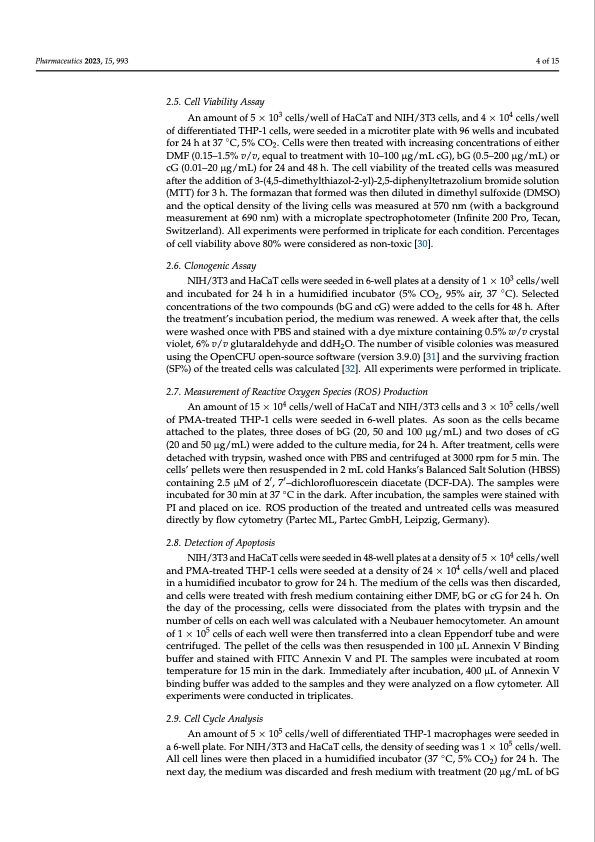
PDF Publication Title:
Text from PDF Page: 004
Pharmaceutics 2023, 15, 993 4 of 15 2.5. Cell Viability Assay An amount of 5 × 103 cells/well of HaCaT and NIH/3T3 cells, and 4 × 104 cells/well of differentiated THP-1 cells, were seeded in a microtiter plate with 96 wells and incubated for 24 h at 37 ◦C, 5% CO2. Cells were then treated with increasing concentrations of either DMF (0.15–1.5% v/v, equal to treatment with 10–100 μg/mL cG), bG (0.5–200 μg/mL) or cG (0.01–20 μg/mL) for 24 and 48 h. The cell viability of the treated cells was measured after the addition of 3-(4,5-dimethylthiazol-2-yl)-2,5-diphenyltetrazolium bromide solution (MTT) for 3 h. The formazan that formed was then diluted in dimethyl sulfoxide (DMSO) and the optical density of the living cells was measured at 570 nm (with a background measurement at 690 nm) with a microplate spectrophotometer (Infinite 200 Pro, Tecan, Switzerland). All experiments were performed in triplicate for each condition. Percentages of cell viability above 80% were considered as non-toxic [30]. 2.6. Clonogenic Assay NIH/3T3 and HaCaT cells were seeded in 6-well plates at a density of 1 × 103 cells/well and incubated for 24 h in a humidified incubator (5% CO2, 95% air, 37 ◦C). Selected concentrations of the two compounds (bG and cG) were added to the cells for 48 h. After the treatment’s incubation period, the medium was renewed. A week after that, the cells were washed once with PBS and stained with a dye mixture containing 0.5% w/v crystal violet, 6% v/v glutaraldehyde and ddH2O. The number of visible colonies was measured using the OpenCFU open-source software (version 3.9.0) [31] and the surviving fraction (SF%) of the treated cells was calculated [32]. All experiments were performed in triplicate. 2.7. Measurement of Reactive Oxygen Species (ROS) Production An amount of 15 × 104 cells/well of HaCaT and NIH/3T3 cells and 3 × 105 cells/well of PMA-treated THP-1 cells were seeded in 6-well plates. As soon as the cells became attached to the plates, three doses of bG (20, 50 and 100 μg/mL) and two doses of cG (20 and 50 μg/mL) were added to the culture media, for 24 h. After treatment, cells were detached with trypsin, washed once with PBS and centrifuged at 3000 rpm for 5 min. The cells’ pellets were then resuspended in 2 mL cold Hanks’s Balanced Salt Solution (HBSS) containing 2.5 μM of 2′, 7′–dichlorofluorescein diacetate (DCF-DA). The samples were incubated for 30 min at 37 ◦C in the dark. After incubation, the samples were stained with PI and placed on ice. ROS production of the treated and untreated cells was measured directly by flow cytometry (Partec ML, Partec GmbH, Leipzig, Germany). 2.8. Detection of Apoptosis NIH/3T3 and HaCaT cells were seeded in 48-well plates at a density of 5 × 104 cells/well and PMA-treated THP-1 cells were seeded at a density of 24 × 104 cells/well and placed in a humidified incubator to grow for 24 h. The medium of the cells was then discarded, and cells were treated with fresh medium containing either DMF, bG or cG for 24 h. On the day of the processing, cells were dissociated from the plates with trypsin and the number of cells on each well was calculated with a Neubauer hemocytometer. An amount of 1 × 105 cells of each well were then transferred into a clean Eppendorf tube and were centrifuged. The pellet of the cells was then resuspended in 100 μL Annexin V Binding buffer and stained with FITC Annexin V and PI. The samples were incubated at room temperature for 15 min in the dark. Immediately after incubation, 400 μL of Annexin V binding buffer was added to the samples and they were analyzed on a flow cytometer. All experiments were conducted in triplicates. 2.9. Cell Cycle Analysis An amount of 5 × 105 cells/well of differentiated THP-1 macrophages were seeded in a 6-well plate. For NIH/3T3 and HaCaT cells, the density of seeding was 1 × 105 cells/well. All cell lines were then placed in a humidified incubator (37 ◦C, 5% CO2) for 24 h. The next day, the medium was discarded and fresh medium with treatment (20 μg/mL of bGPDF Image | Green Exfoliation of Graphene

PDF Search Title:
Green Exfoliation of GrapheneOriginal File Name Searched:
pharmaceutics-15-00993.pdfDIY PDF Search: Google It | Yahoo | Bing
Salgenx Redox Flow Battery Technology: Power up your energy storage game with Salgenx Salt Water Battery. With its advanced technology, the flow battery provides reliable, scalable, and sustainable energy storage for utility-scale projects. Upgrade to a Salgenx flow battery today and take control of your energy future.
| CONTACT TEL: 608-238-6001 Email: greg@infinityturbine.com | RSS | AMP |